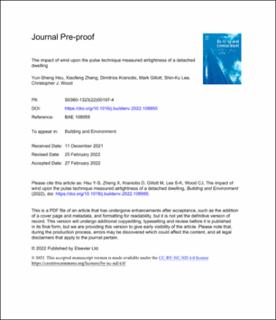| dc.contributor.author | Hsu, Yun-Sheng | |
| dc.contributor.author | Zheng, Xiaofeng | |
| dc.contributor.author | Kraniotis, Dimitrios | |
| dc.contributor.author | Gillott, Mark | |
| dc.contributor.author | Lee, Shin-Ku | |
| dc.contributor.author | Wood, Christopher J. | |
| dc.date.accessioned | 2022-05-27T13:43:58Z | |
| dc.date.available | 2022-05-27T13:43:58Z | |
| dc.date.created | 2022-03-10T20:38:04Z | |
| dc.date.issued | 2022-03-14 | |
| dc.identifier.issn | 0360-1323 | |
| dc.identifier.uri | https://hdl.handle.net/11250/2996522 | |
| dc.description.abstract | The novel Pulse technique measures the building airtightness in a dynamic approach, involving a lowpressure pressurisation process, typically in 1-10Pa. It is known that the wind effect is one of the main sources of uncertainty for airtightness testing. The literature review revealed that the wind impact on measuring building airtightness has been explored in relation to the steady pressurisation method (i.e., the blower door), while there is limited research investigating the validity of the Pulse measurement under various natural wind conditions. In this study, in total, 423 Pulse tests were performed to measure the building airtightness of a five-bedroom dwelling located at the University of Nottingham, UK, under natural wind conditions. The viability of the Pulse technique for delivering airtightness measurements under different wind conditions was assessed, including the impacts of the wind speed and the wind direction on the Pulse measurements. Based on the measured air leakage rates, the threshold of maximum wind speed that led the Pulse measurements to have repeatability greater than ±10% is 5.0m/s at 2.2m above ground level (i.e., approximately equivalent to the meteorological wind speed of 7.9m/s). On the other hand, the directional wind study showed that at lower wind speeds, the wind direction has a lesser influence on the Pulse measurement than the wind speed itself. Practically, multiple Pulse tests are recommended for minimising the wind impact on building airtightness measurement when adverse wind conditions are present. | en_US |
| dc.language.iso | eng | en_US |
| dc.publisher | Elsevier | en_US |
| dc.relation.ispartofseries | Building and Environment;Volume 215, 1 May 2022, 108955 | |
| dc.rights | Attribution-NonCommercial-NoDerivatives 4.0 Internasjonal | * |
| dc.rights.uri | http://creativecommons.org/licenses/by-nc-nd/4.0/deed.no | * |
| dc.subject | Bygningsfysikk | en_US |
| dc.subject | Building physics | en_US |
| dc.subject | Building airtightness | en_US |
| dc.subject | The Pulse technique | en_US |
| dc.subject | Unsteady approaches | en_US |
| dc.subject | Wind impacts | en_US |
| dc.subject | Wind speed | en_US |
| dc.subject | Wind directions | en_US |
| dc.title | The impact of wind upon the pulse technique measured airtightness of a detached dwelling | en_US |
| dc.type | Peer reviewed | en_US |
| dc.type | Journal article | en_US |
| dc.description.version | acceptedVersion | en_US |
| dc.source.articlenumber | 108955 | en_US |
| cristin.ispublished | true | |
| cristin.fulltext | postprint | |
| cristin.qualitycode | 2 | |
| dc.identifier.doi | 10.1016/j.buildenv.2022.108955 | |
| dc.identifier.cristin | 2008952 | |
| dc.source.journal | Building and Environment | en_US |
| dc.source.volume | 215 | en_US |
| dc.source.issue | 215 | en_US |
| dc.source.pagenumber | 35 | en_US |
| dc.subject.nsi | VDP::Arkitektur og bygningsteknologi: 531 | en_US |
| dc.subject.nsi | VDP::Architecture and building technology: 531 | en_US |

